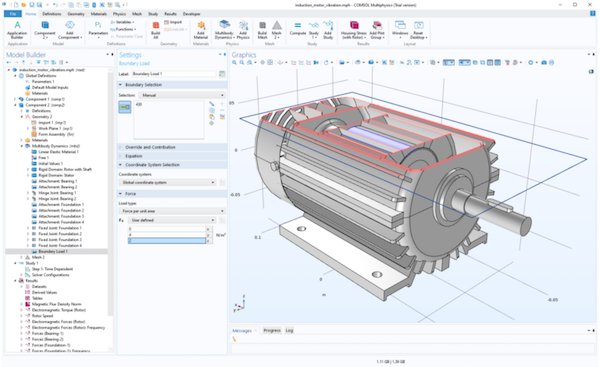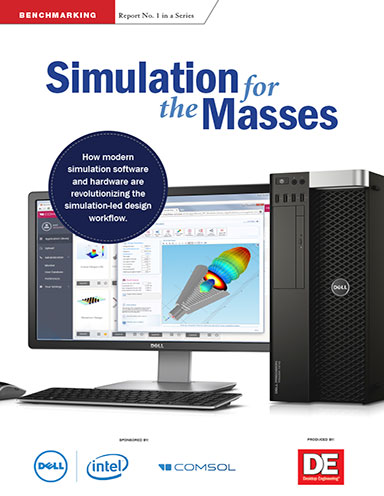COMSOL Previews Multiphysics 5.6
New release includes faster solvers, better handling of CAD assembly, new graphics features, and new modules for fuel cells, electrolyzers, polymer flow, and control systems.

An electric motor simulation in COMSOL Multiphysics version 5.6 where a clip plane is used for easier access to the inside of the model for assigning material properties and loads. Image courtesy of COMSOL.
Latest in Multiphysics Software
Multiphysics Software Resources


Latest News
October 15, 2020
At its online conference earlier in October, COMSOL previewed the new release of Multiphysics 5.6. Scheduled for release later this fall, the update provides faster and more memory-efficient solvers, better CAD assembly handling, application layout templates, and new graphics features (including clip planes, realistic material rendering, and partial transparency). There are also four new simulation modules for fuel cells, electrolyzers, polymer flow, and control systems.
Graphics enhancements include an update for clip plans that enables easier selection of boundaries and domains inside of complex CAD models. Other graphics improvements include visualizations that are partly opaque and partly transparent; realistic material rendering; and the ability to make imported images part of a visualization.
“When our customers launch CAD models, they often have multiple layers of complexity,” says Bjorn Sjodin, vice president of product management at COMSOL. “They may need to see inside. Many of our commercial customers have been asking for the ability to click away part of a model by sliding a click plane through the geometry. It is a small change, but provides a dramatic usability improvement.”
The big news, however, is a significant improvement in solver times. According to COMSOL, the solution time has decreased by 30% or more for many types of simulations. The solvers are more efficient with respect to computation time and memory usage for multicore and cluster computations. Handling of larger CAD assemblies has also been improved.
“We have a lot of users that are leveraging larger, industrial-sized models,” Sjodin, says. “We have commercial users going to CAD assemblies and trying to solve the physics them. Many of our customers are large organizations using clusters, and to get speed-up on clusters for these strongly coupled multiphysics models is a challenge.”
He added that COMSOL has worked to leverage additional CPU compute resources so that its solvers can scale on each node, as well as on the cluster as a whole.
In version 5.6, the general performance improvements provide a roughly 50% decrease in assembly and solution time for midsized benchmark models. For performance on clusters, the finite element assembly and solution time has decreased by 30% for many types of analyses.
According to COMSOL: “Another improvement for users running on clusters includes an upgraded domain decomposition method that can now be used for a wider range of simulations. For acoustics simulations, a new boundary element method formulation enables analyses of an order of magnitude larger acoustic volumes. For CFD simulations, the solution time on clusters has decreased by about 30% using iterative solvers and about 50% using domain decomposition. A new eigenvalue solver called FEAST, well suited for parallel computations, has several important uses, including mode analysis for optical waveguides and laser cavities. In the Optimization Module, a new general-purpose, gradient-based solver called IPOPT has important applications in, for example, shape optimization.”
New Modules
The new release also includes four new simulation products.
The Fuel Cell & Electrolyzer Module provides engineers with modeling and simulation tools for hydrogen fuel cells and water electrolyzers, along with general-purpose tools for realistic fluid flow and electrochemical simulations. According to COMSOL, engineers can include charge transport, electrode reactions, thermodynamics, gas-phase diffusion, porous media flow, and two-phase flow when analyzing and optimizing technology for hydrogen vehicles and energy storage.
The Polymer Flow Module allows engineers to use modeling and simulation to design and optimize processes involving non-Newtonian fluids, for applications in the polymer, food, pharmaceutical, cosmetics, household, and fine chemicals industries. The new module can account for a variety of multiphysics effects, including. when the properties of a fluid vary as a function of temperature and composition, to model curing and polymerization, or when a non-Newtonian fluid affects a mechanical structure, such as for a biological fluid moving through a peristaltic pump, the company says.
The Liquid & Gas Properties Module is used to compute properties for gases, liquids, and mixtures such as density, viscosity, thermal conductivity, and heat capacity as functions of composition, pressure, and temperature.
The update also allows systems engineers to use the new LiveLink for Simulink product for cosimulation of COMSOL Multiphysics and Simulink from MathWorks. Using the tool, engineers can insert a COMSOL Multiphysics block into a Simulink model for running nonlinear COMSOL Multiphysics simulations in the time domain driven by Simulink.
More COMSOL Coverage
Subscribe to our FREE magazine, FREE email newsletters or both!
Latest News
Related Topics




